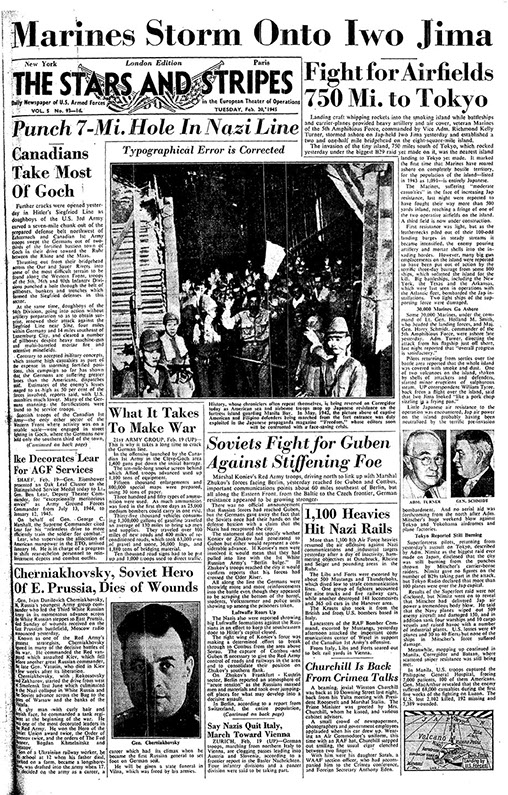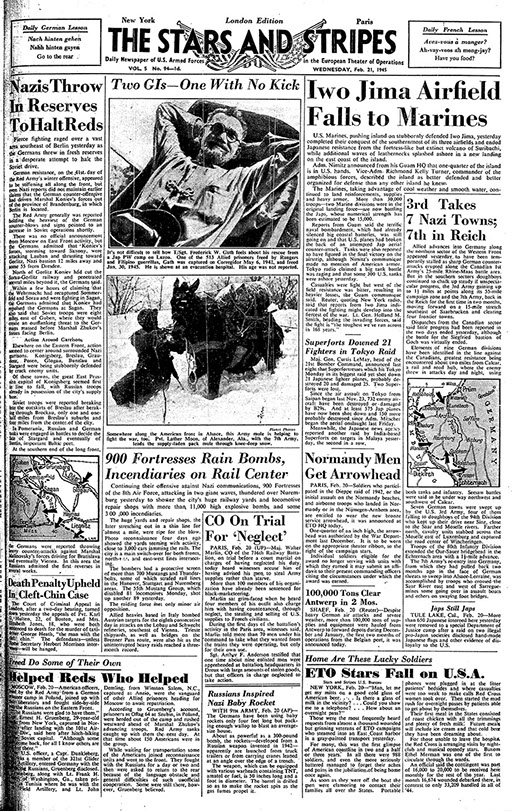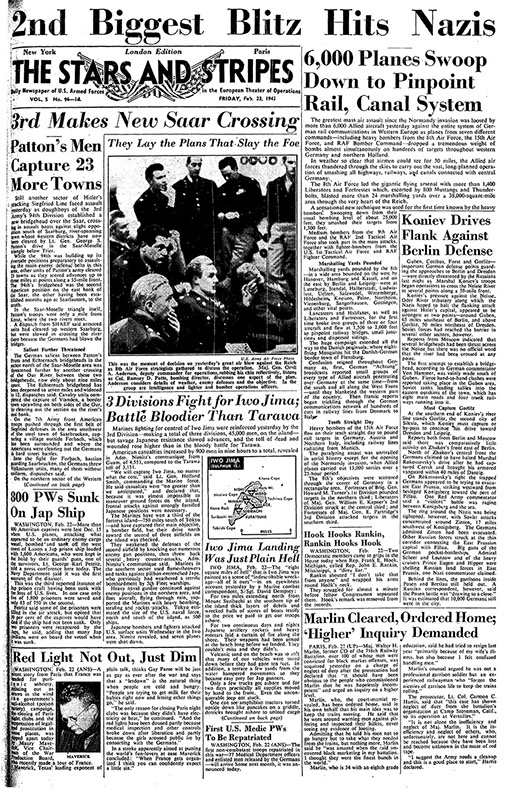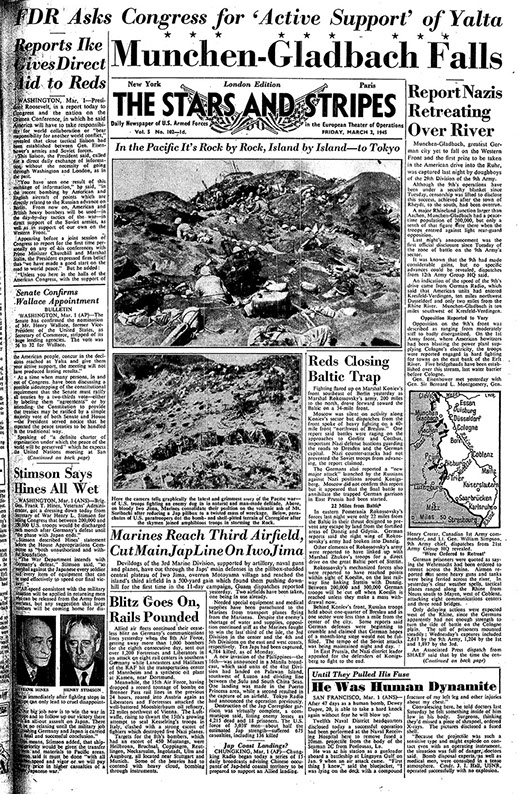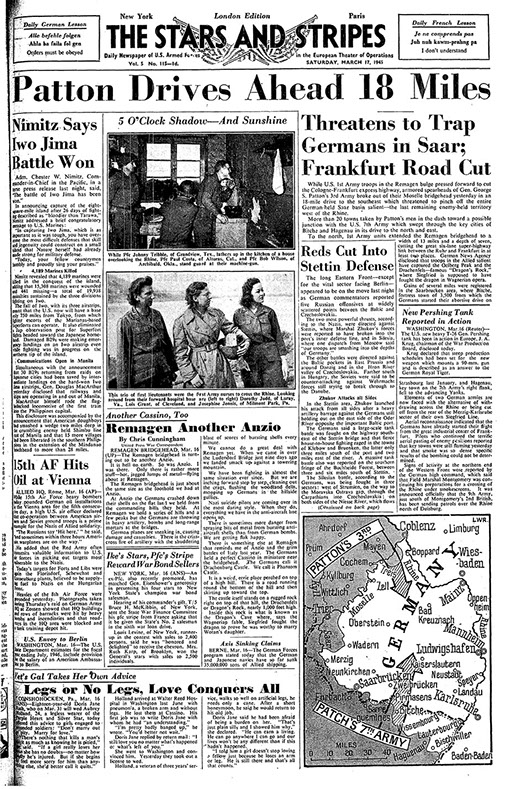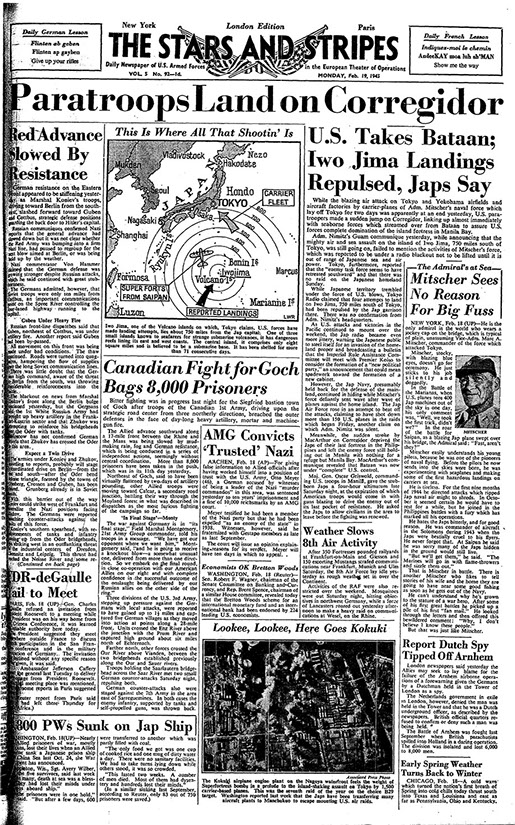Monday, Feb. 23, 2015
THE STARS AND STRIPES
Page 5
View gallery
By Michael S. Darnell
Stars and Stripes Staff Writer
Photographer almost missed historic moment
It took only 1/400th of a second to change history.
Associated Press war correspondent Joe Rosenthal’s famous photograph of Marines raising the flag on Iwo Jima came to symbolize not only the battle but American perseverance during World War II. The image endures as the very symbol of the Marine Corps.
And, it almost didn’t happen.
On Feb. 23, 1945, after five days of intense fighting, the 2nd Battalion, 28th Marines seized Mount Suribachi from its entrenched Japanese defenders. Three Marines — 1st Lt. Harold Schrier, Sgt. Ernest Thomas Jr., and Sgt. Henry Hansen — raised the American flag atop the summit.
When he heard of the flag raising, Rosenthal wanted a picture of it.
“I didn’t know they were carrying a second flag,” Rosenthal told the Los Angeles Times in 1985. “I already knew a flag was on top, and I wanted just to see for myself and also take in the view.”
As it turned out, Rosenthal would see more than a spectacular view and a flag fluttering in the wind.
Lt. Col. Chandler Johnson, who was later killed on Iwo Jima, wanted a bigger flag — one so large that “the men at the other end of the island can see it.”
He sent 2nd Lt. Albert Tuttle back down the mountain to find such a flag.
Tuttle hit the jackpot on Navy landing ship LST-779.
In a 2013 interview published in a Jet Propulsion Laboratory newsletter, Alan Wood, a communications officer aboard LST-779, recalled Tuttle coming aboard his ship.
“I was on the ship when a young Marine came along. He was dusty, dirty and battle-worn, and even though he couldn’t have been more than 18 or 19, he looked like an old man,” Wood said. “ ‘Do you have a flag?’ he asked me. ‘Yes,’ I said, ‘What for?’ He said something like, ‘Don’t worry, you won’t regret it.’ ”
Legend has it that the 37-square-foot flag had been saved from a Pearl Harbor salvage depot and brought to Iwo Jima aboard LST-779.
“I was just rummaging around looking for anything that might be of use when I found this apparently brand-new flag in a duffel bag with some old signal flags,” Wood said in an interview with World War II Magazine in 2000. “It was a large flag, and I was glad to find it because we were out of large flags. Little did I know how famous it would one day become.”
With the flag in tow, Tuttle had to negotiate his way back through the raging battle and then climb the steep slopes of Suribachi for a second flag raising — this time with an AP photographer there to capture the moment.
Still, Rosenthal almost missed the shot while exchanging small talk with Sgt. Bill Genaust, a combat correspondent who, along with Pvt. Bill Campbell, had escorted him up the mountain.
Rosenthal recalled the event in a 1995 interview with the Marine Corps’ history division 1995 publication on the Iwo Jima battle:
“He said ‘I’m not in your way, am I, Joe?’ And I said, ‘Oh, no.’ I turned from him and out of the corner of my eye I said, ‘Hey, Bill there it goes,” Rosenthal said. “By being polite to each other, we both damn near missed the shot. I swung my camera around and held it until I could guess that this was the peak of the action, and shot.”
In that split second, Rosenthal captured what is inarguably the most famous photograph to come out of the war. It was the first photograph to win the Pulitzer Prize in the year of publication. It’s been replicated in everything from postages stamps to butter sculptures.
It has also become the face of the Marine Corps, serving as the basis for the Corps’ War Memorial in Washington, D.C., as well as a replica statue at the recruit training depot in Parris Island, S.C.
The National Museum of the Marine Corps’ architecture is designed to replicate the shape and form of the flag raising, which is fitting as it currently houses both the first and second flags raised on Mount Suribachi.
Rosenthal continued to work as a photographer until he retired in 1981. In 1996 he was named an honorary Marine by Marine Corps Commandant Gen. Charles Krulak.
“I took the picture,” Rosenthal said in his later years. “The Marines took Iwo Jima.”



